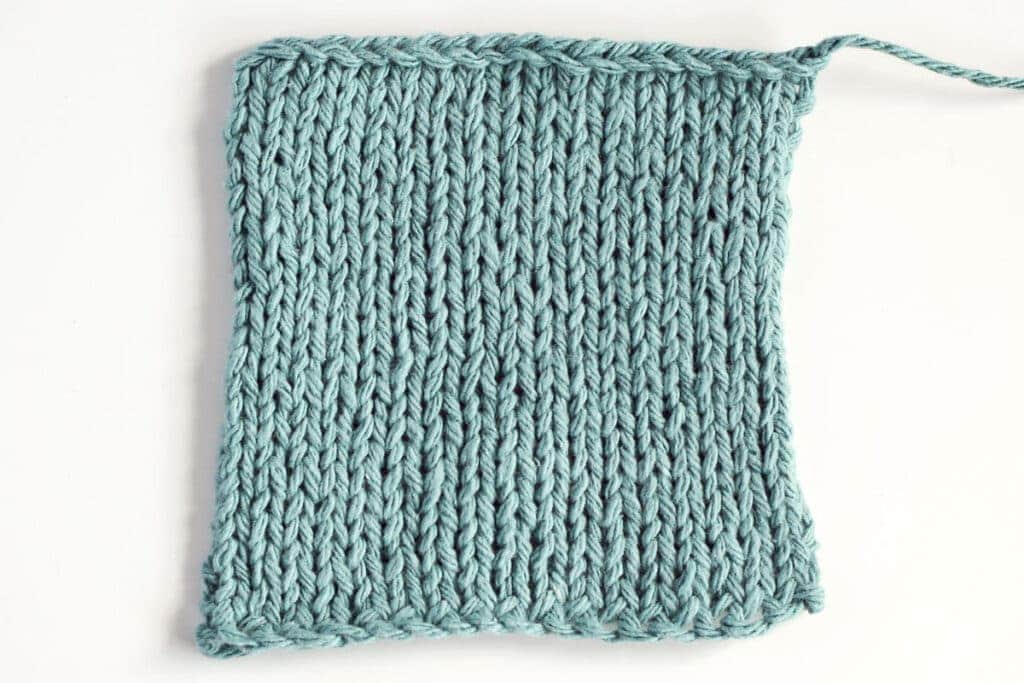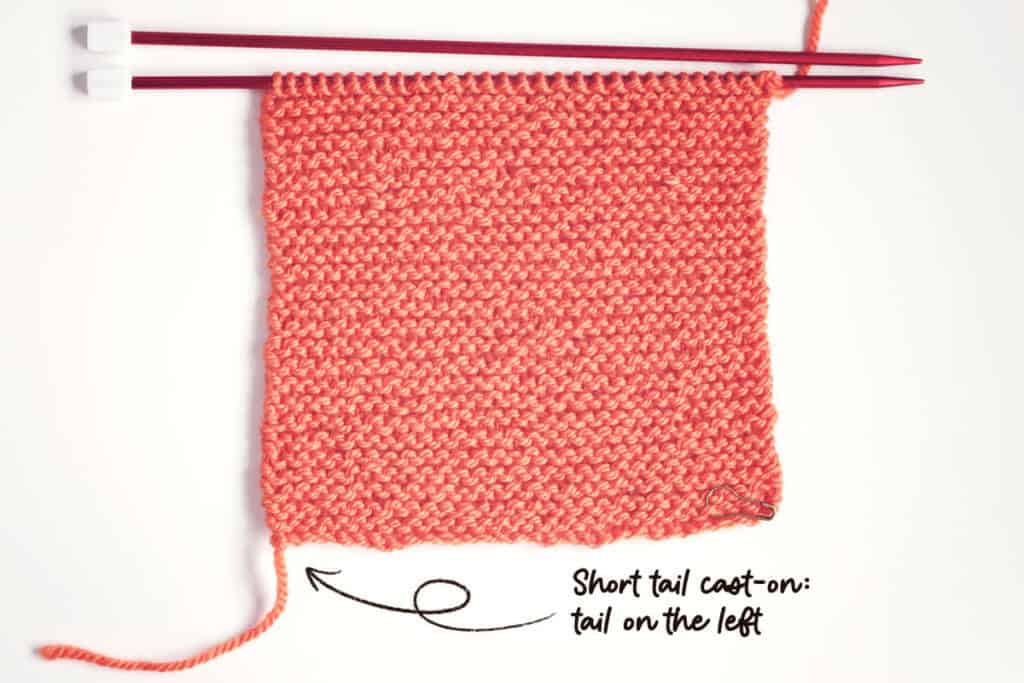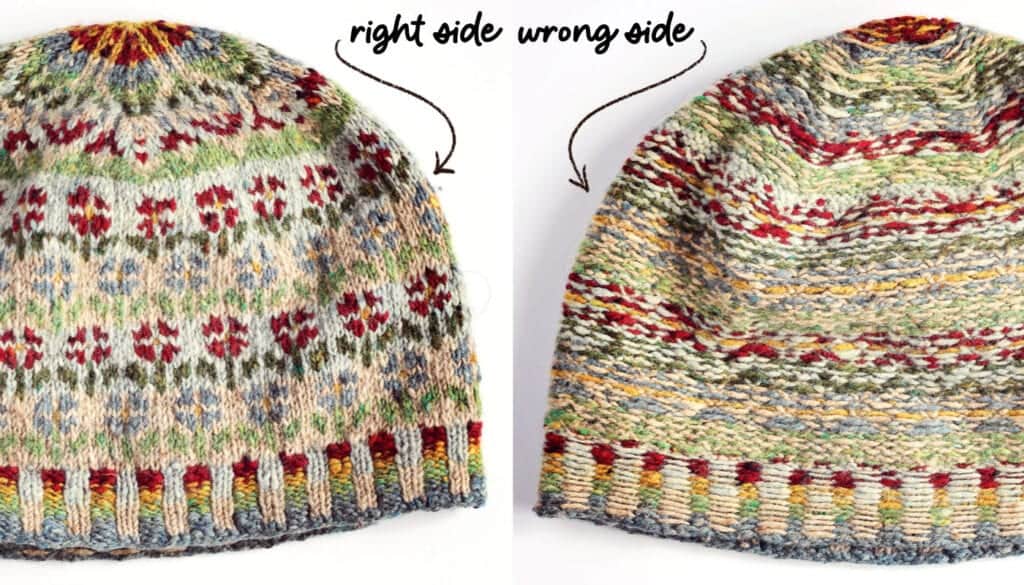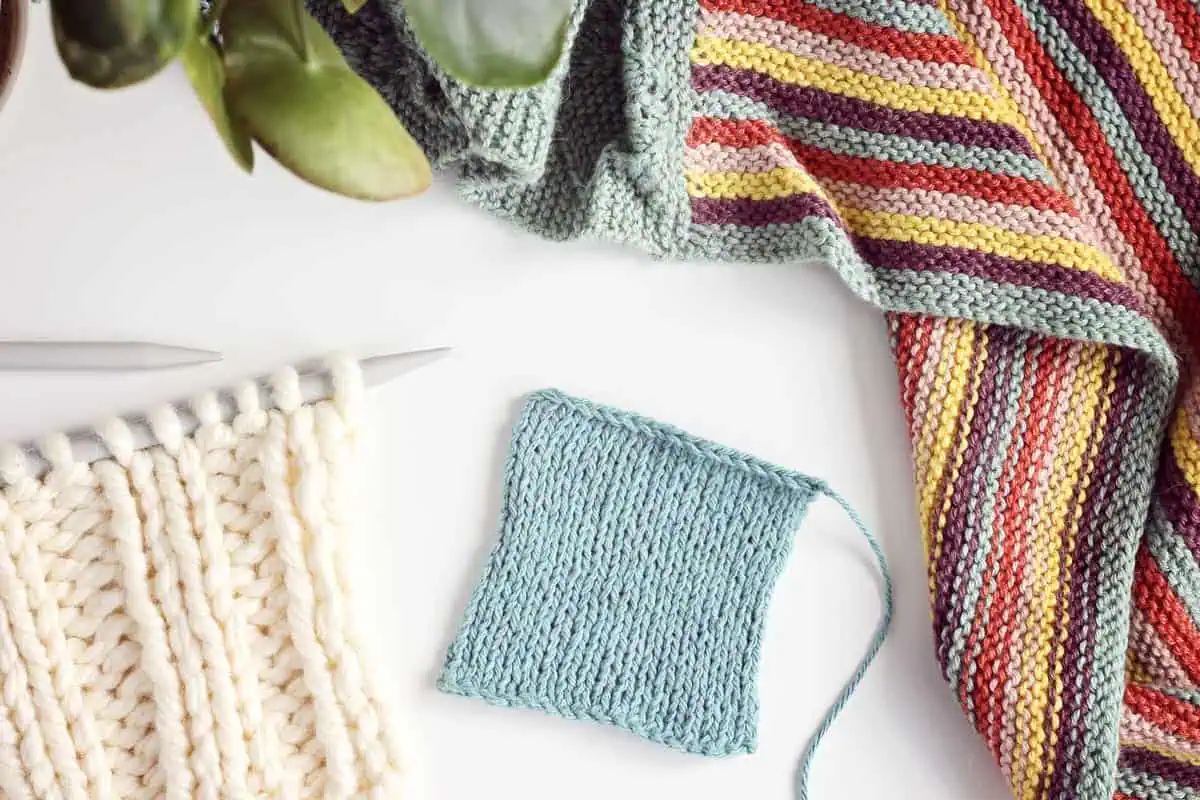Are you wondering what is the wrong side in knitting?
Now that you’ve got the hang of the knitting basics, you’re looking to upskill with something a little more complex. Suddenly, you find patterns talking about the right side and the wrong side, and you’re left wondering, what’s the difference? Does it even matter?
It matters a lot. Being able to tell the right side from the wrong side of your fabric is super important if you want your project to turn out well.
While some projects, like scarves or blankets, can be reversible, most garments usually need you to identify which side of your work is the right one. This can be tricky, especially for beginner knitters.
Thankfully, with a little bit of guidance, being able to spot the right and the wrong side of your knitting can be easier than you think.

At A Glance: What is the wrong side in knitting?
The wrong side in knitting is the side of the fabric that you don’t want people to see.
The right side is opposite – it’s the outward-facing or the “pretty” side that’s meant to be seen by everyone.
Most of the time the fabric will look different on the right side vs the wrong side, but sometimes it can be hard to tell.
Knowing the difference between the sides is important and helps you understand your knitting better.
- The wrong side of knitting is the side that won’t be visible when the project is finished.
- The right side of a knitting project is the side intended to be visible when finished.
- The side facing you while knitting is always the side you name or identify.
Right Side vs Wrong Side: What’s the Difference?
To understand what is the wrong side in knitting, we also need to understand the right side.
In knitting, every piece has two sides: the wrong side (WS) and the right side (RS).
Knowing the difference between these two sides is an important part of making sure your finished projects turn out the way you want.
These terms are essential when following patterns, and they can play a big role in the appearance and structure of your finished work.
Let’s break it down:
- Wrong Side (WS): This side isn’t intended to be shown in the final piece. It’s often the side that’s against your body when worn. Also called the back side or inside of the fabric.
- Right Side (RS): The pretty side that you intend to show in your finished project. It’s often the side with all the stitch patterns and details.
It’s always the side facing you while you’re knitting that you name or identify as the wrong/right side.
Some knitting stitch patterns are reversible, like garter stitch, so both sides look the same. In those cases, you might not have to worry about identifying the wrong and right side as much.
But, for most projects, you’ll want to keep track of these sides to make sure that your pattern comes out the way you want.
Defining the Sides in Knitting
The right side refers to the side of the knitted fabric that’s intended to be seen. In other words, it’s the side of the work that will be on display when the project is finished, and is usually the side that’s more visually appealing with the most detailed or textured pattern.
On the other hand, the wrong side is the side of the knitting that is intended to be hidden or inside of the project.
Stockinette stitch shows this really well.

The right side is the smooth side with all the ‘V’ shaped stitched, while the wrong side is the bumpy, purl side.
But these terms are somewhat subjective and can change depending on the pattern or the knitter’s preference.
In some patterns, what’s typically considered the ‘wrong side’ may be used as the ‘right side’ for an interesting effect – like reverse stockinette.
Here, the right side is actually the bumpy purl side and the wrong side is the smooth side.
So you can see that determining the right side and wrong side in knitting depends on the specific pattern or instructions being followed.
Why is it Important to Know the Right and Wrong Sides?
So, why is it important to know the wrong side?
Well, knowing what is the wrong side in knitting helps you achieve that perfect finish.
The ‘wrong side’ is essentially the back of your work, and it’s typically hidden in the finished product.
But if you’re not careful, you might end up showcasing the wrong side instead, or adding details on the wrong side.
And it helps you to follow your pattern more easily – if your pattern calls for you to purl every wrong side row, it helps to able to recognize this side.
Here’s why you need to be able to tell the wrong side from the right side of your knitting:
- Making it look good: Identifying the right and wrong sides helps with positioning pattern elements like cables or colorwork. When these details are positioned properly your project can look neater and more finished.
- Stitch consistency: Different stitch patterns may have specific instructions for the right and wrong sides. Recognizing these sides allows you to follow the pattern accurately, such as purling on the wrong side and knitting on the right side.
- Interpreting knitting instructions: Patterns often refer to the sides of a project when giving directions, especially for shaping, increasing, or decreasing stitches. Understanding which side is which helps you to and follow the pattern more easily.
- Finishing Touches: When you’re putting together a knitted garment or adding cute buttons or embroidery, you need to know which side is which. You want your seams to match up and be hidden on the inside, and your embellishments to be on the right side for that polished look. And if you’re weaving in your ends as you work, you definitely want them to be hidden on the wrong side.
How to Identify the Wrong Side in Knitting
Now we understand the importance of the wrong side, but how do you tell the difference between the two sides of your knitting?
Let’s take a look at some different tips you can use to figure it out:
When you hold the knitting in your left hand ready to work a row:
– If the right side of the fabric is facing you, you’re about to work a right side row.
– If the wrong side of the fabric is facing you, you’re about to work a wrong side row.
Read Your Knitting Pattern
Most knitting patterns start on the right side, so your instructions might say something like:
Row 1 (RS): K2, sl1 wyif.
If you’re beginning with a right side row then all the odd-numbered rows are usually right-side rows, and all the even-numbered rows are wrong-side rows.
You can count your knitting rows manually, or use a row counter to keep track. If your counter says you’re about to work an odd-numbered row, you know you’re about to work the right side.

This isn’t always the case, though. Sometimes you’ll have a pattern that has a setup row or starts on the wrong side (WS), so always make sure you’re reading the knitting pattern carefully.
Also, in general, you’ll find yarn overs, knit two togethers, cable crosses and other stitches or shaping are usually worked on the right side, and the wrong side is usually just a purl or knit row. Again, this isn’t always the case, especially with more advanced patterns or lace worked on both sides.
Recognising the Wrong Side by Looking at the Stitches
You can often tell which side is the wrong side by looking at the stitches themselves.
This is easier if you’re working in a stitch that looks very different on the right and wrong sides
Let’s take another look at that simple stockinette swatch.

On the right side, the stitches appear smooth and neat with a “V” pattern, while the wrong side is bumpy, showing off the purl stitches.
So if you’re starting a row and see that the smooth “V” shaped stitches are facing you, you know you’re about to work a right side row.

But if you’re starting a row and the bumpy side is facing you, you’re about to work a wrong side row.

The same goes for most other non-reversible stitch patterns, like this slipped stitch pattern.
With reversible stitches, like garter stitch, it’s not always obvious what is the wrong side in knitting.
In this case, you can look at other clues. So if your project has used other design elements or stitch patterns, like a section of lace, these might have a more obvious wrong side that you can identify more easily.
And if you’re working stripes in garter stitch, there will be a noticeable transition between the two colors on the wrong side that can help you distinguish between the sides.

Using Stitch Markers to Identify the Right Side
A stitch marker makes it easy to identify what is the wrong side in knitting.
Attach a locking stitch marker to the right side of your knitting early on in the project for an easy way to find the right side of your project.
This is my favorite way to keep track of the right side of my knitting. And it’s particularly useful if you’re working in a reversible stitch pattern where it’s hard to tell the right or wrong sides apart.
The stitch marker acts as a quick visual reference for whether you’re on the right side or wrong side of your work.
So when you start a row, if that marker is on the side of the fabric that’s facing you, you know you’re about to knit a right side row.
If the stitch marker is on the side of your knitting that’s facing away from you, you know you’re about to knit a wrong side row.
Check the Cast-On Tail
Your knitting will almost always have a cast-on tail hanging from the edge.
The position of this yarn tail can be an easy way to tell the sides apart, but since different cast-ons leave the tail in different places you need to know which cast-on you used.

If you’ve used a standard short tail cast-on like a knitted, cable or backwards loop cast-on: the cast-on tail will be on the left-hand side when the right side of your knitting is facing you.
So if the cast-on tail is on the opposite side as your working yarn, you’re about to start knitting a right side row.
If the cast-on tail is on the same side as your working yarn, then you’re about to begin working a wrong side row.

If you’ve used a long tail cast-on: the cast-on tail will be on the right-hand side when the right side of your knitting is facing you.
So if the cast-on tail is on the same side as your working yarn, you’re about to work a right side row.
If the cast-on tail is on the opposite side as your working yarn, you’re about to work a wrong side row.
Identifying Right Side and Wrong Side in Different Fabrics
Now that we’ve covered how to identify the right and wrong sides of your knitting, let’s see how they look in common stitch patterns.
Different techniques produce different results on both sides of your fabric.
To tell the difference between the right and wrong side you just need to keep an eye out for specific characteristics depending on the pattern or technique you’re using.
So let’s take a look at how to determine what is the wrong side in knitting for common stitch patterns.:
Stockinette Stitch
Stockinette stitch is one of the most common knitting stitch patterns, and it’s a great stitch to show the difference between knit stitches and purl stitches.

Here you can see that the right side of the work is smooth, with V-shaped knit stitches. The wrong side shows purl bumps.
Reverse stockinette stitch is simply the opposite – the right side is the bumpy purl side, and the wrong side is the smooth knit side.
Garter Stitch
Garter stitch is reversible, so it can be tricky to determine which side is the right side and which is the wrong side.
Most of the time, the first row that you knit after casting on is the “right side” of the work.
The easiest way to keep track is to use the stitch marker method to mark it this side after you’ve worked a few rows.
But if your pattern doesn’t specify a side then you can decide which side you prefer to use as the right side.
Since both sides in garter stitch look identical, I often use the cast-on row to help me determine the right side. To do this, look closely at both sides of the cast-on and choose neater one – that’s your right side in garter stitch.
Ribbing
Ribbing is another stitch which is reversible.
Both sides will have columns of knit and purl stitches, so it can be tricky to figure out the right side vs the wrong side if you haven’t marked it.
But depending on the type of ribbing and the number of stitches cast on, the columns may not always be in the same position.

If you have an even number of columns your ribbing will look the same on both sides. You can see this in this 2×2 rib swatch which has 6 columns of knit and purl. No matter what side you’re working on, the swatch always starts a row with a knit column and ends with a purl column.

This swatch also shows a 2×2 rib pattern, but this time it’s worked over an odd number of columns – 5 in this case.
You can see that this creates symmetrical edges, since every right side row on this swatch starts and ends with a knit column. But on the wrong side of the work these columns become purl columns.
Lace
Lace is often worked on a background of stockinette stitch, but it can also be made in garter stitch.
In most cases, stockinette stitch lace will have an obvious right and wrong side, while garter stitch lace tends to be reversible.

This trellis lace swatch shows the smooth stockinette stitch on the right side, and the bumpy purls on the wrong side.
Unless you’re working a more complex lace pattern, you’ll usually find that pattern rows (the rows with the yarn overs and decreases) are worked on the right side, and the wrong side is a knit or a purl row.
Cables
Cable knitting will have a noticeable wrong side.

You’ll be able to see that the actual cables will only be visible from the front side of the work, and the reverse will look pretty boring in comparison.

Colorwork and Stranded Knitting
Colorwork involves using two or more colors in your knitting, creating motifs and patterns by changing colors mid-row.
For Fair Isle, stranded knitting and intarsia, the yarn strands, floats or joins are almost always carried on the back of the work which creates a very obvious reverse side.

Stripes also have an obvious wrong side – the color change creates visible dashes on the back where the stitches of the new color interlock with the old color.

You can see the dashes where the yarn changes color on the inside of these socks.

The same thing happens when you knit stripes in garter stitch, which makes it much easier to see the wrong side.
Ending With a Wrong Side Row
You might come across the phrase “… ending with a wrong side row” in your pattern instructions.
But what does it mean and how do you do it?
Simply put, the last row of your knitting should be on the wrong side (back side) of the fabric. You’re then ready to start the next section on a right side row.
For stockinette stitch, this means that your last row should be a purl row.
If you’re using a reversible stitch like garter stitch, hopefully your pattern tells you which side is the wrong side, and you’ve kept track of it using markers or a row counter. If not, you can simply choose which side to end on, or use the tips mentioned earlier to figure out the wrong side.
So, there you have it! Now you know what is the wrong side in knitting.
By being able to tell the difference between the right and wrong sides, you’ll have the confidence to create projects that look polished and professional. Whether you’re deciphering stitch patterns, using stitch markers, or checking the position of the cast-on tail, these techniques will guide you on your knitting journey.



